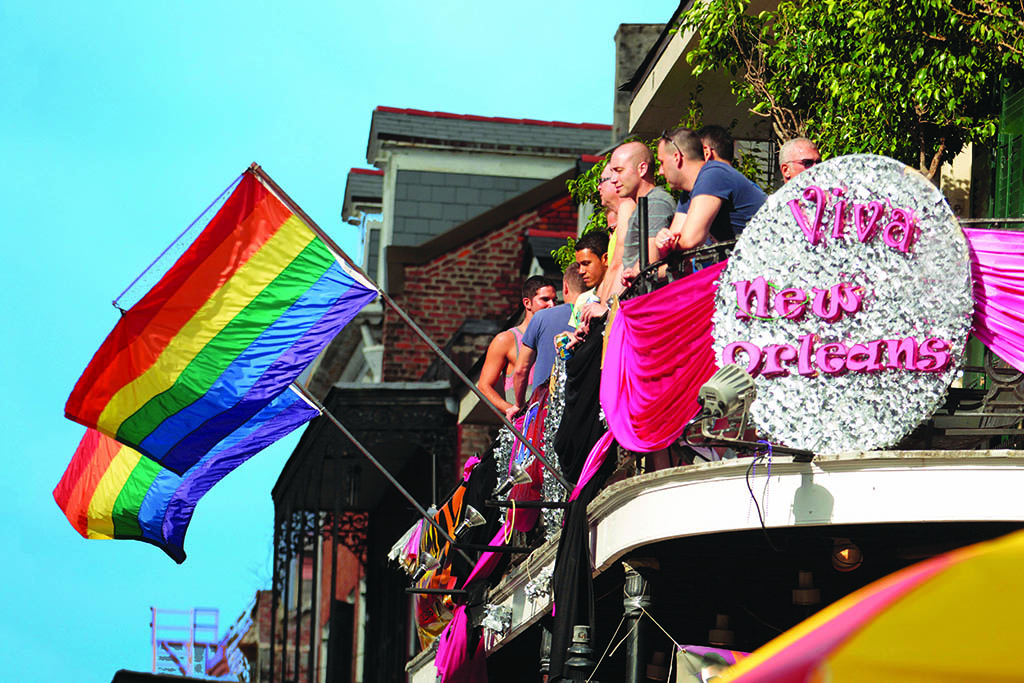After hours in New Orleans generally conjures ghost tours, jazz clubs, and French Quarter strolls. A gay traveler might even end up at Bourbon Pub or Oz, the city’s two most famous gay clubs. But I’m standing in the back courtyard of Cane & Table (1113 Decatur St., Tel: 504-581-1112. www.caneandtablenola.com), a dimly lit, off-the-radar lounge in the French Quarter that attracts the hipster set. Outside, under the moonlight, an organized drag show begins. The performance with three bearded drag queens is understated, a little trashy, effortlessly charming, and unarguably engaging. When the show is over 30 minutes later, the mixed gay and straight audience demands an encore, and the three entertainers return for one final number. It’s not uncommon to have these types of events in hetero-dominant establishments, but the Big Easy is on the brink of change, one where the LGBT community is rapidly growing and becoming more visible in the city’s progressive flair. In fact, New Orleans is defying expectations, experiencing a renaissance where contemporary hotels are opening, imaginative chefs are thinking outside the box, and the gay scene is flourishing outside its traditional environments.
For centuries, New Orleans (founded in 1718) has lured travelers with its distinctive culture and heritage that spans Cajun, Creole, French history, voodoo culture, jazz, and, naturally, it’s world-renowned Mardi Gras. With the city’s growth, however, there’s more to offer than meets the eye, and the visitor numbers are dramatically increasing every year. The proof is in the gumbo: according to New Orleans CVB, the city welcomed 9.52 million visitors in 2014 (a 2.6 percent increase from the previous year) who spent $6.81 billion, an all-time record for this quaint city.
A good indication of New Orleans’ whirlwind expansion is the brand-new terminal at Louis Armstrong New Orleans International Airport, set to debut in 2018. The $826 million project will feature 30 gates, a 2,000-car parking garage, a central utility plant, and ground transportation staging area. The new terminal is so massive, it’s projected to have a $3.2 billion annual economic impact on tourism.
The local streetcar service, RTA, is also getting a major renovation. The Regional Transit Authority is expanding with several new routes and stations with an official grand opening scheduled for September 2016. Visitors and locals can expect new service into burgeoning neighborhoods and historic districts like Treme, Marigny, St. Roch, and Bywater.
Speaking of Bywater District, this quiet neighborhood was the first sign of New Orleans’ renaissance when it was gentrified less than a decade ago. A former “rough” part of town is now brimming with outdoor cafés, yoga studios, a brand-new riverfront park, Crescent Park (which was part of Bywater’s revitalization project), and trendy new restaurants like Mission Chinese and The Franklin. It’s also going to be home to new hotels and hostels, further lending to its metamorphosis. Bywater is notable for New Orleans’ first hipster movement, one where the majority of gay locals outside the French Quarter are moving thanks to the ‘hood’s rich heritage, welcoming atmosphere, and new-found stylishness. In fact, many locals already know the Bywater as it is the home to The Country Club (634 Louisa St., Tel: 504-945-0742. www.thecountryclubneworleans.com), which features a heated saltwater pool, sauna, bar, and casual restaurant. The weekend brunch here is one of the best around and features good food, strong drinks, and fun people watching.

Crescent city bridge over the Mississippi River in New Orleans.
Cari Roy, a nationally recognized psychic and gay rights supporter, has lived in Bywater for 25 years. “I fell in love with the area because it was funky and very diverse with artists, musicians, writers, and other fringe folks. It was a wonderful blend of diverse households. As New Orleans has become a hot spot for tech, films, and startups, demand for housing has become sky high, and Bywater was already a super-cool area.”
Roy, who says you cannot be a real New Orleanian without being tied to the gay community, is happily immersed in New Orleans gay culture. “My clients are gay, my neighbors are gay, and my tenants are gay. Even though we’re in the south, no one in New Orleans is really actively trying to pray the gay away. We embrace it and under- stand it as an asset to our city.”
New Orleans’ hotel landscape is famously getting the attention it deserves, not only because new, gay-friendly brands are moving in (like Four Seasons (2017) and Virgin Hotel (2018), but longtime favorites are receiving modern facelifts. W French Quarter (316 Chartres St., Tel: 504-581-1200, www.wfrenchquarter.com. Rooms from $230), recently transformed all 97 guest-rooms to reflect the artistic energy and intrigue of jazz and tarot in the Crescent City. The central courtyard has become an exciting social center (with new monthly fitness classes partnered with The Sweat Social) thanks to the tiered water fountain, vine-covered walls, and an outdoor pool (one of few in New Orleans). Thankfully, the redesign wasn’t too modern, and the hotel managed to retain NOLA soul.
Just a few blocks away, Ritz-Carlton New Orleans (921 Canal St.,Tel: 504-524-1331. www.ritzcarlton.com. Rooms from $304) is unarguably the most luxurious hotel in the city. As a landmark, 1908 beaux arts Maison Blanche building, the hotel received a $2 million exterior façade restoration in 2015 for further preservation, in addition to newly designed Club Level suites and renovations to its pampering spa with steam/sauna, fitness center and pool. Of the dozens of club level lounges I’ve experienced, Ritz-Carlton New Orleans Club Lounge is easily my favorite. Palatial and elegant, it’s designed to feel like a Gar- den District mansion, with sparkly chandeliers, antiques, and centuries-old paintings. It’s worth the splurge with all-day culinary offerings (including breakfast), complimentary wine, beer, and cocktails, dedicated concierge, and three exquisite, Old-World settings: a salon, a library, and a parlor.


